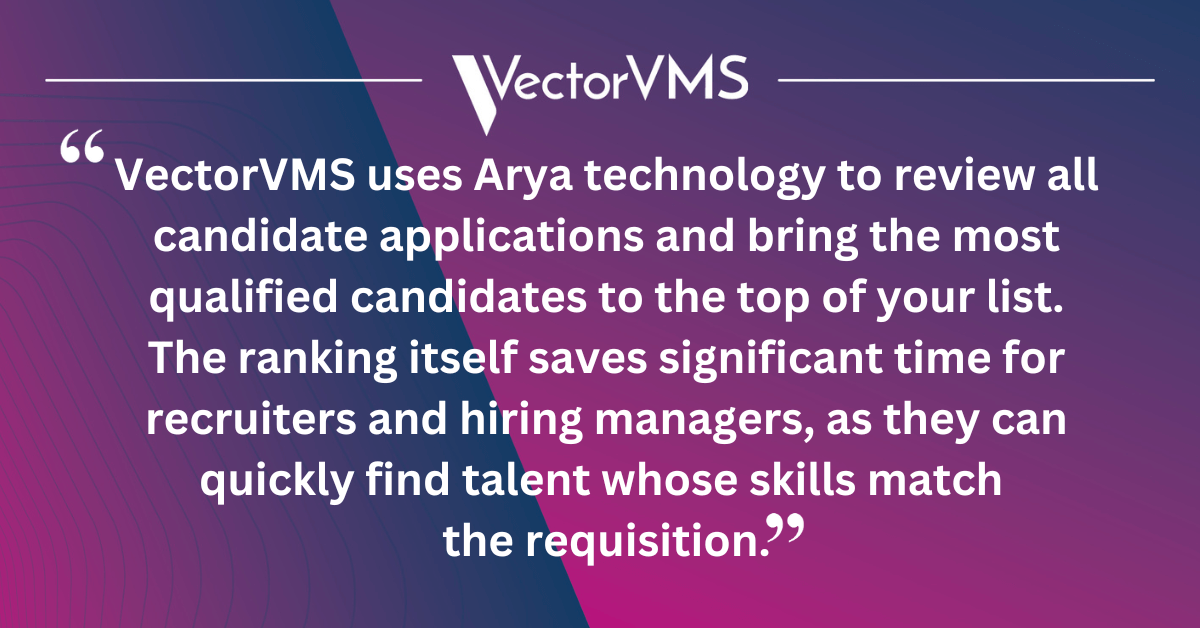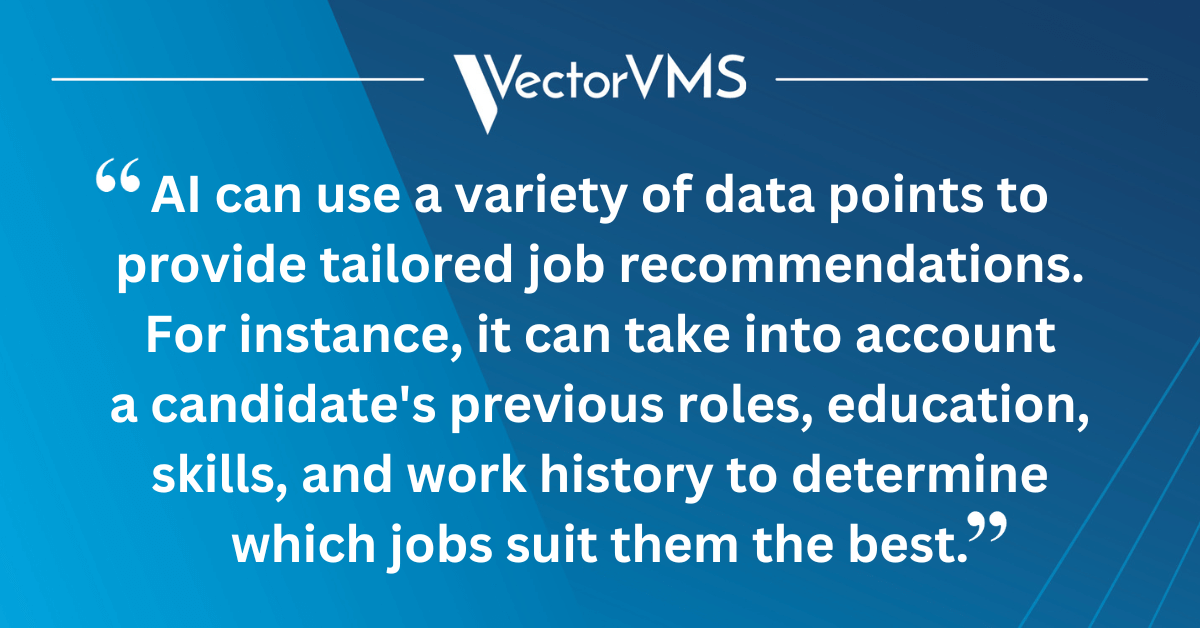Artificial intelligence (AI) has become increasingly prevalent in the recruitment industry. Many companies are integrating it into their vendor management systems (VMSs) to automate repetitive tasks and speed up the hiring process.
The increased use of AI reflects the industry’s current need to modernize and make recruiting more efficient. A 2022 report about candidate experience shows that job seekers want a faster recruitment process—58% of people expect to hear back from companies within one week after their job application. Organizations need to utilize technology that can keep up with these demands. Otherwise, they can fall behind and miss out on qualified talent. AI is a valuable solution for accelerating the hiring process.
While AI has plenty of benefits, having a human connection in the recruitment process remains equally important. Candidates dislike feeling that they’re interacting with a robot throughout the entire hiring process. The best way to work with your workforce —whether full-time, contingent, or both— is to combine the right amount of automation with a human touch. In this article, we discuss the key benefits and limitations of incorporating AI into your talent acquisition pipeline.
How AI Changes the Recruiting Game
One way that VectorVMS clients and managed service providers (MSPs) are driving efficiencies in their recruitment workflows is by introducing artificial intelligence and machine learning (ML).
This approach drives recruiter efficiency by automating tasks where appropriate, while still maintaining a human touch. With these technologies, recruiters can save time and focus on more high-value tasks, such as building relationships with candidates and clients. Here are three recruitment tasks that the combination of people and AI can improve:
1) Applicant Resume Screening
Usually, organizations use a VMS to send job requisitions to their staffing suppliers, who will later send back suitable candidates for the company to review. That’s where the process typically starts to slow down. Companies manually review the candidates one by one to narrow down a shortlist of qualified candidates. While this is still a viable option, introducing AI into this step could reduce the time spent screening submitted candidates.
For example, VectorVMS uses Arya technology to review all candidate applications and bring the most qualified candidates to the top of your list. The ranking itself saves significant time for recruiters and hiring managers, as they can quickly find talent whose skills match the requisition. However, human eyes are still necessary to review those candidates. In this scenario, AI acts as a guide, suggesting which candidates to prioritize based on data indicating who might be the best fit for the role.
AI recruiting software can look beyond keyword matching and take into account a variety of success metrics to ensure accuracy. Arya, for example, uses 300 success metrics that go beyond word-for-word keyword matching. It also reviews a candidate’s past experiences, the industries they’ve participated in, or the size of the companies they’ve worked for. These complex algorithms prevent biases and ensure that qualified candidates aren’t missed in the process.
MORE ABOUT AI | ’The Power of AI and How It Can Transform Your Talent Acquisition Strategy’

2) Past Candidate Matching
In a 2023 Bullhorn survey, recruitment professionals cited the talent shortage as their top challenge for the year—organizations and staffing firms are finding it difficult to recruit qualified candidates to fill open positions. Leveraging internal talent pools can empower your organization to overcome these shortages.
Let’s suppose your organization has silver medalists or people who have applied for other roles previously. You can use AI to look at past candidates and determine whether they’re a match for the new role. Maintaining this pool of candidates can speed up your hiring process, as you already know them and know they’re going to be a good fit for the role. The AI will do the matching job for you, but it’s still up to your team to evaluate the candidate.
3) Overall Candidate Experience
In addition to benefiting recruiters and clients, AI can also improve overall talent engagement. By incorporating AI into your workflow, you can enhance the candidate experience in the following ways:
i) Provide Tailored Job Recommendations
AI can use a variety of data points to provide tailored job recommendations. For instance, it can take into account a candidate’s previous roles, education, skills, and work history to determine which jobs suit them the best. Additionally, AI can also analyze a candidate’s interactions with a company’s website or social media profiles to get a better sense of their interests and preferences. AI uses this information to recommend jobs that are relevant to the candidate’s background and interests, which can help improve the candidate experience and increase the likelihood that they will apply for the job.

ii) Assist Candidates Through Chatbots
Chatbots are a great example of how to use AI to enhance the candidate experience. They can answer a candidate’s basic questions, such as inquiries about job descriptions, application status, or general company information. Additionally, chatbots can help simplify the application process by guiding candidates through the application and screening process.
Using chatbots saves time and effort for both the candidate and the recruiter or hiring manager, as the chatbot can handle the initial screening and qualification process, leaving more time for human interaction with the most qualified candidates. Chatbots can also provide a 24/7 support system for candidates to receive assistance outside of regular business hours.
YOU MIGHT BE INTERESTED IN READING | ‘Improved Recruiting Efficiencies With AI: The Trickle-Up Benefits to Your Organization’
iii) Inform Applicants About Their Process
Rejecting candidates might be the least fun part of recruiting, but it’s an important one. For job seekers, nothing’s worse than applying for a role just to fall into a black hole of no communication. According to the previously mentioned candidate experience report, 75% of candidates have been ghosted after a job interview, and 65% would be more inclined to reapply for a role at a company if they received feedback during their first try.
Sending rejection emails to hundreds of candidates definitely sounds like a daunting task. With AI, you can automatically set up rejection notifications for candidates that fail to meet a certain threshold. For example, if a person only meets 50% of the criteria, you can set a threshold that, once triggered, automatically sends the rejection notification. If working with vendors, they would receive the notification and relay to the candidate that they weren’t selected for the role. It’s also possible to add a disposition reason and comments to the notification if needed.
Hiring With Help From AI
Whether you manage a full-time, hybrid, or fully contingent workforce, incorporating AI into your workflow can improve recruiter efficiency, shorten time-to-fill, and increase retention rates—all while improving the overall candidate experience. Through AI technology, you can stay ahead of the competition and improve the way you attract qualified talent to your organization.
At VectorVMS, we understand the importance of a seamless recruitment process that integrates multiple technologies. Contact us to learn more about our contingent workforce management solutions and how they can change your recruiting process.
 Meet the Expert
Meet the Expert
Taylor Ramchandani – VP of Strategy
Taylor Ramchandani is responsible for the management and strategic planning of the VectorVMS vendor management system. Taylor is committed to client satisfaction and to ensuring VectorVMS technology meets the current and future needs of clients and managed service providers (MSPs). She uses market research and in-depth industry experience to create products and services that make extended workforce management efficient and intuitive. Taylor oversees product development, marketing, and business partnerships for VectorVMS and is responsible for driving innovation for contingent workforce management. Connect with her on LinkedIn.



